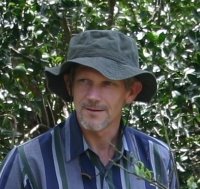We spent the last week or so of March in western Kenya on a farm just outside Eldama Ravine town. It's an area where the highlands in that region end in an escarpment that descends to the Rift Valley. The change in elevation makes for an extraordinarily diverse ecosystem, from highland forest and grassland to dry, hot
acacia savannah in the valley floor.
I wrote down a hundred or so bird species that I encountered on the trip, and I'm sure could easily have logged over hundred and fifty if I'd made a foray or two into the lower-lying bush areas. Here's a list of several of the ones I found especially notable:
Wahlberg's honeybird (
Prodotiscus regulus), alternatively named sharp-billed honeyguide--a rather drab bird, apart from prominent white outer tail feathers, but a new species for me
Hartlaub's turaco (
Tauraco hartlaubi)--an altogether splendid bird in violet, green and scarlet, with with dashing white facial markings; had better than usual views of one this time, a particular pleasure since we do not have this species in our Mbale, Uganda area
African crowned eagle (
Stephanoaetus coronatus)--Africa's most powerful raptor; son Jonathan's sharp eyes spotted one soaring over the forest as we were starting our return trip to Uganda; we pulled over to the shoulder of the road and enjoyed watching for a little while
Red-fronted parrot (
Poicephalus gulielmi)--had flocks flying overhead daily en route to feeding or roosting places
Dusky turtle dove (
Streptopelia lugens)--this was a new one for me also; viewed several of the birds while there; they do occur in Uganda, but only in southwestern and far northeastern parts of the country
Common scimitarbill (
Rhinopomastus cyanomelas)--it had been years since I'd last seen one of these handsome black birds with white wing and tail spots
Cape robin-chat (
Cossypha caffra)--I don't come across these very often, as they tend to be found at higher elevations than where we live, and not in my past experience in the same area as the related white-browed robin-chat (
Cossypha heuglini, which we also enjoyed seeing while there)
Cape wagtail (
Motacilla capensis)--a pair of them, foraging on the same patch of roadside grass with a couple of the common African pied wagtail (
Motacilla aguimp)
Yellow-breasted apalis (
Apalis flavida) and chestnut-throated apalis (
Apalis porphyrolaema)--both of these were new to me, both observed in
acacia trees at or not far from the forest edge
Sulphur-breasted bush-shrike (
Malaconotus sulfureopectus)--saw a juvenile of this species that I often enjoyed watching at home in Malawi during growing-up years
Yellow-bellied waxbill (
Estrilda quartinia)--I first got acquainted with these lovely, gregarious little birds in the highlands of Malawi, where the field-guides call them East African swees.
Streaky seedeater (
Serinus striolatus), thick-billed seedeater (
Serinus burtoni) and yellow-rumped seedeater (
Serinus reichenowi)--the last of these was a new species for me
African golden-breasted bunting (
Emberiza flaviventris)--gorgeous birds that I came across on several walks as they foraged on the ground, then flew up to a branch of a tree or shrub when I got too close
Red-chested cuckoo (
Cuculus solitarius)--there were quite a number of these attractive birds drawing attention to themselves by their loud three-note, oft-repeated (even throughout the night!) calls; had some excellent views of a pair of them late one afternoon; sometimes they are called "rain-birds" because of their habit of calling frequently around the time that the rainy season begins
Heard the calls also of the black cuckoo (
Cuculus clamosus) and the African emerald cuckoo (
Chrysococcyx cupreus); Klaas's cuckoo (
Chrysococcyx klaas) both heard and seen while there
Chin-spot batis (
Batis molitor)--another bird familiar from our yard in Malawi, but not seen so far in Uganda







